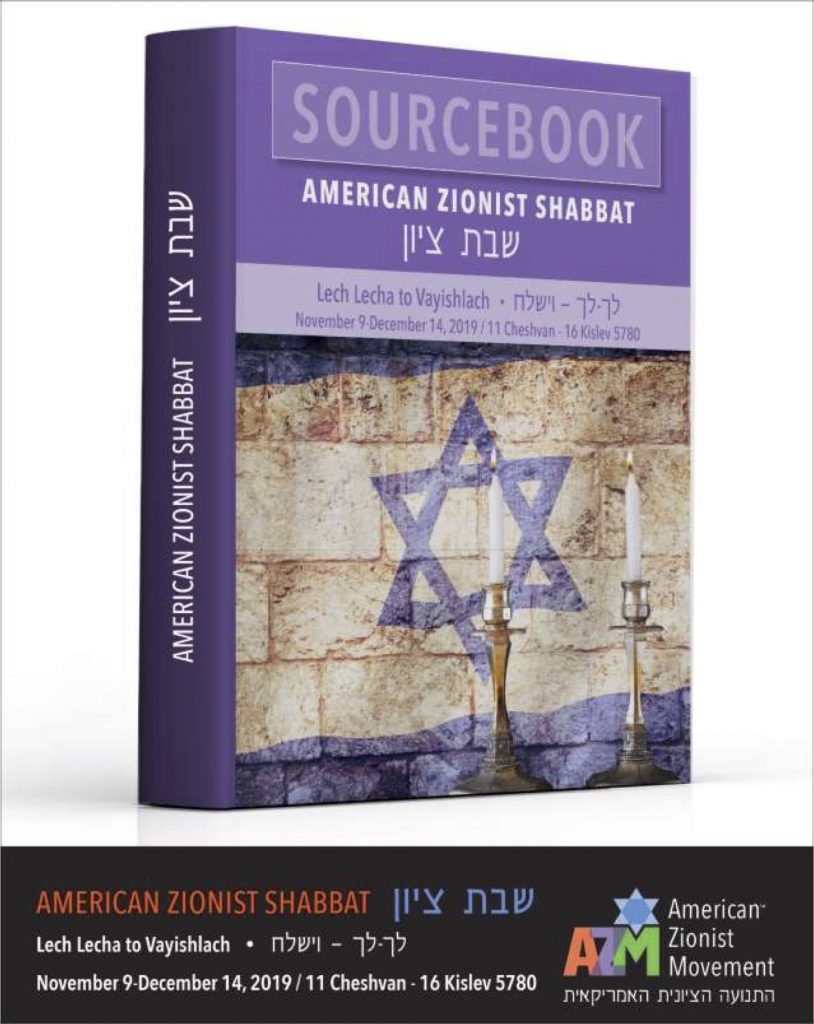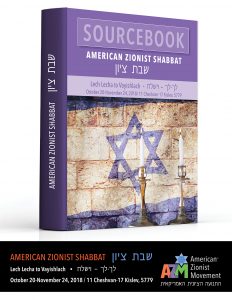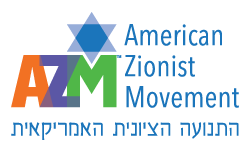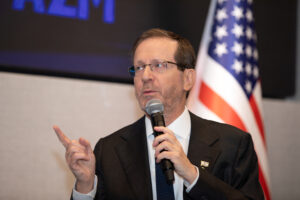November/December 2019 – CHESHVAN/KISLEV 5779

The American Zionist Movement is pleased to update for 2019 -5780 and share the “American Zionist Shabbat” initiative Source Book which was launched in two years ago. This project continues during the period from Parshiot Lech Lecha (November 9th / 11 Cheshvan) to Vayishlach (December 14th / 16 Kislev), 2019-5780.
In this Zionist Shabbat Source Book you will see resources for discussing Zionism in synagogues, schools and the community during this period, including links to materials easily available on the internet.

————————————————————————————
2018
October 2018 – Cheshvan 5779
AMERICAN ZIONIST SHABBAT – שבת ציון

The American Zionist Movement is pleased to update for 2018 -5779 and share again the “American Zionist Shabbat” initiative which was launched last year. This project continues during the period from Parshiot Lech Lecha (October 20th/11 Cheshvan) to Vayishlach (November 24th/16 Kislev), 2018-5779.
Below you will see resources for discussing Zionism in synagogues, schools and the community during this period, including links to materials easily available on the internet.
In May 2018 AZM added a Jerusalem Shabbat Supplement in partnership with the World Zionist Organization and this addition is included here as well at the end of the Source Book.
The American Zionist Movement has launched a series of programs in 2017-2018, which we have described as the “AZM Year of Zionist Anniversaries”. As we mark 120 years since Theodor Herzl launched the modern Zionist movement when he convened the first Zionist Congress in Basel, we will also celebrate major milestones this Fall during this Jewish year 5778. Therefore, AZM is launching a new American Zionist Shabbat initiative over the period of each Shabbat from Parshiot Lech Lecha to Vayishlach (October 28, 2017 through December 2, 2017). These weeks coincide with the Shabbat before the Centennial of the Balfour Declaration until the Shabbat after we commemorate 70 years since the United Nations Partition Resolution adoption (8 Cheshvan- 14 Kislev 5778).
AZM has begun this initiative, a resumption of the Zionist Shabbat/Shabbat Tzion program that AZM and the World Zionist Organization conducted in the past, in order to have greater dialogue within American Jewry on the significance of Zionism and its continuing relevance to our people and community. We hope that during these weeks, and commencing with the Shabbat of Parsha Lech Lecha – the journey of the Jewish People – Rabbis will speak about Zionism in their sermons, drashot and writings; day schools, yeshivot and Hebrew schools will connect their students to Zionism as related to the weekly Torah readings; and, that congregations, community organizations and Jewish institutions will share materials and encourage programs and discussions on Zionism.
AZM has compiled this initial Source Book, drawn from materials developed and shared by our AZM organizations and others, to each of whom we express our thanks and appreciation for their leadership and dedication, in order to provide a resource for conversations on Zionism during this period of American Zionist Shabbat. We will continue to grow and expand this guide and program through these weeks, and in coming months and years, and encourage others to share sources with us at azm@azm.org.
As we have seen Zionism attacked from various groups and people in America, it is important that Zionists of all backgrounds come together in our united support for the State of Israel as she enters her 70th year. That is what happened when Herzl first brought together a broad coalition of Zionists 120 years ago to build the movement which would lead to the establishment of a Jewish state in our ancestral land. Today Zionism is very much alive as we connect Jews worldwide with our homeland and as we continue to support the vibrant democracy, culture and contributions of Israel and the Jewish people.
This 2017-18/ 5777-78 “Year of Zionist Anniversaries” includes recognizing:
- 50 years since the reunification of Jerusalem following the Six Day War in June 1967;
- 120 years since Theodor Herzl convened the First Zionist Congress in Basel, Switzerland in August 1897;
- 100 years since the Balfour Declaration was issued in November 1917 by the British Foreign Secretary;
- 70 years since adoption of the United Nations Partition Resolution in November 1947; and, culminates with celebrating the…
- 70th anniversary of the founding of the State of Israel in May
Please share, forward and implement your own thoughts in celebration of Zionism and the America Zionist Shabbat.
The American Zionist Movement wishes to thank the leaders of each of the AZM organizations who have contributed materials, ideas and thoughts in developing the American Zionist Shabbat Sourcebook.
For Further Information, to make contributions of materials or resources, please contact:
Herbert Block, AZM Executive Director Alicia Post, AZM Program Director
212.318.6100 ext.6946 212.318.6100 ext.6947
Chomer Ladrush for a Zionist Shabbat 5779
Rabbi Paul Golomb
AZM Vice President for Programming
The book of Genesis tells the story of a couple becoming a people. After a narrative of primeval history – Creation, expulsion from the Garden, flood and Babel – the tale begins with Abram and Sarai and concludes with B’nai Yisrael. How a married couple not merely initiates a multigenerational family, but rather creates an ‘Am, is a saga in the formation of an identity. We see this development in both who is included and who drops out.
The story is told over four generations, concluding with the twelve sons of Jacob who will become the tribes of Israel. Although we must bracket out the one daughter, Dina, whose fate in Scripture remains unknown, all of Jacob’s progeny participate in the covenant God first formed with Abraham. The same cannot be said for the previous generations. Ishmael and then Esau are left out of this particular covenant. Why is that the case, and what may we learn about the formation of the Jewish people from their exclusion?
Ishmael is an elusive and enigmatic character. He is introduced in utero, the child that will be born to Hagar the Egyptian, and yet will be given a name by his father Abraham that connects him to God. He is observed by Sarah, after the birth of Isaac, “playing.” (It’s meaning here is deeply ambiguous) When banished to the wilderness, God hears his weeping, sustains him and his mother with water, so that he will grow to be a hunter, and after taking an Egyptian wife, fulfills his destiny to be the progenitor of a nation of twelve princes. With a brief mention in the story of Joseph being borne to Egypt, the Ishmaelites disappear from Scripture altogether. There is one other indirect reference. After the ‘akeidah, Isaac goes to Be’er Lahai Ro’I, the spring associated with Hagar and her unborn child.
There is nothing in the scriptural references to Ishmael that suggest he should not be a recipient of the covenant God forged with his father, except the identity of his mother. Ishmael is not the child of Sarah, but rather of her handmaiden. Subsequent midrash will interpret Ishmael’s “playing” in a negative light, and also intimate that his status as an outdoorsman makes him unsuitable. These are rationales. In Scripture, Ishmael’s disqualification is his mother.
Esau, on the other hand, is every much a child of Isaac and Rebecca as is Jacob. The text is much clearer that his absence from the covenant is due to his own deficiencies. In my own reading, Esau failed not only in the spurning of a birthright, but was also incapable of personal growth. Isaac preferred Esau as the oldest child, but also appreciated the “softer” qualities of Jacob. He longed for each of his children to develop that which other possessed. Jacob did so: The voice is the voice of Jacob, but the hands are the hands of Esau. Esau did not.
In the next generation, all of the children carry on the covenant and become the people Israel. This is so even for the four sons – Dan, Naftali, Gad and Asher – who were born to handmaidens, as was Ishmael! All twelve nevertheless evidenced emotional and spiritual maturing as did Jacob, particular in the ten sons’ confrontation with Joseph over Benjamin. Indeed, the Genesis saga of the formation of a people is sealed in the fifth generation, when Manashe and Ephraim silently accept the cross-hand blessing of their grandfather, Jacob. The foreignness of their mother and the bitter fraternal enmity of the previous two generations are dispelled.
What are we to learn about identity formation from this saga? First, that it begins with blood. The covenant is passed on by both Abraham and Sarah, together part of the same extended family that made the journey from Ur to Haran to the Land. Hagar was not on that journey. Indeed, blood remains significant enough that Isaac’s wife must be from the same clan.
It begins with blood, but it does not end there. Esau, whose bloodlines are identical to Jacob’s, is nonetheless not found worthy. The shortcoming is therefore not external – a matter of heritage – but rather internal – a matter of character. He could not rise spiritually to the level of blessing. Jacob’s children, irrespective of their parents, could. None of them were saints; they showed signs of arrogance, jealousy and a willingness to dissemble. They also proved in moments of crisis that they could transcend their flaws and display genuine courage. The mostly dysfunctional family of Jacob is transformed into the people Israel.
The idea of identity formation that unfolds in the Genesis saga can be regarded in both historical and psychological terms. A clan grows and spreads. Over time the familial connections become less significant than other factors that hold the people together. An individual, as well, understands oneself initially in relation to those who are closest, most often parents and siblings. Then, in the process of maturing, the sense of identity through family is overtaken by new means of self-recognition. Blood, however, never disappears.
Whether we employ the historical or the psychological model, we learn from Scripture, that our Jewish identity is not reducible to just one thing. To be a Jew is not merely familial, or historical, or national, or cultural, or confessional. I would also suggest that being Jewish cannot eliminate or fully ignore any of these factors either. Yes, we all privilege some elements of our Jewish identity as more important, even vital, to us. All the others remain.
The vitality of our Jewish identity is found in the willingness to embrace all the elements: family (mishpacha), people (‘am), covenanted nation (goy kadosh), obligation (mitzvah), and Land (Ha’Aretz). Is there a hierarchy to these values? Only, I would suggest, in our own choices of which touches us more deeply.
A verse in Leviticus (26:42), nonetheless, captures it all. In a promise of restoration after exile (the curses enumerated in parashat Behukotai), God says: Then I will remember My covenant with Jacob, as well as my covenant with Isaac, and also my covenant with Abraham, and I will remember the land. The covenant – that which delimits and defines our Jewishness – is not one thing. It is at least three things; and the Lad! To be a Jew can be nothing less.
Notes for a Zionist Shabbat 5778
Rabbi Paul Golomb
AZM Vice President for Programming
What does it mean to speak of Zionism in a Shabbat d’rash or d’var Torah? I am referring specifically to an attempt to infuse a Zionist message into talk about the parashah, rather than departing from the text.
We should note first that drawing a Zionist theme from a parashah – any Torah portion – is not obvious. The Book of Genesis focuses primarily on those personalities that become the People Israel. It is a family drama, and the principal motifs that are drawn from its chapters often center on interpersonal dynamics.
The balance of the Books of Humash – Exodus through Deuteronomy – focus on Torah as instruction and the revelation that occurred at Sinai. Sinai, most significantly, is located in the wilderness, Midbar, a place that is nowhere, and therefore can be anywhere. And the revelation itself is inscribed on tablets of stone that Moses can carry down from the mountain. An extended stretch of the Book of Exodus is given over to a detail description of a mishkan, where the tablets will be housed in an Ark and the priestly administrations performed on behalf of the people will take place. The principal feature of the mishkan is its portability. It can go anywhere!
In the balance of Scripture, Sinai (or Horeb) is mentioned a mere nine times. After the first few verses of Joshua, Moses is not mentioned at all. As Sinai disappears, it is replaced by Zion, a fixed place where God and Israel may meet. The word “Zion” is not found at all in Torah! Tanakh is rooted in the Land, but Torah is not. Even the haftarot, drawn as they are from the balance of Scripture only rarely refer to Zion.
The reading of Torah and haftarah in the Synagogue is designed for a people scattered around the world. The foundation for the Jews is the portable scroll. Zion is an abstraction, a place set aside for a messianic time. Even though many synagogues have added the language that “it is beginning of the flowering of the days of the Messiah” in order to acknowledge the restoration of the Jewish State, Zion, from the Scriptural point of view, remains stubbornly in the future. What can we glean from our Torah readings that we may apply to today?
When reading Torah in the synagogue, the Land is rarely in the foreground, but it is always in the background. Consider the lives of Abraham, Isaac and Jacob as narrated in Genesis. In the parashiot Lekh L’kha and VaYishlah, Abraham and Jacob have travelled outside of the Land, to Egypt and Aram respectively. They both have been impelled to do so because remaining is inhospitable. In Abraham’s case it is famine, for Jacob it is the enmity of Esau. While away, they both enrich themselves. Egypt and Aram have been very good for them materially. Yet, both return to the Land! What compels this return?
Isaac, on the other hand, never leaves. Poignantly, parashat Hayei Sara, suggests that he nonetheless moved away from his parent’s home and dwelt in Beer Lahai Ro’I, the spring associated with Hagar and Ishmael. Ishmael, Isaac’s half-brother, we are told, is both one who is free to roam far and wide, and also the prince of twelve nations. Isaac feels the urge to roam as well, and yet he does not. He steadfastly remains rooted to the Land.
In the characterizations of the three Avot, the Land is not a source of material wealth, nor is it the basis of emotional security, and yet it is an irresistible draw. From the tales of Genesis, we may conclude that the Jewish connection to the Land of Israel cannot be expressed in either a material or emotional bonding. It is deeper and more ineffable. Zionism is predicated on the notion that Jewish identity cannot be reduced to devotion to Torah or personal sense of relatedness to other Jews. Both are indeed essential and are the principal qualities that draw one to the synagogue. Inexorably, however, Jewish identity is also tied to a powerful, if occasionally elusive, tie to a particular Land. The tie is not the proverbial “milk and honey,” nor the innumerable songs of Zion intoned by the waters of Babylon, nor even the command and promise of the Eternal. It is found in the meaning of being a Jew.
A final thought: Each morning in traditional liturgy, this verse from Leviticus (Chap. 26) is recited: I will remember My covenant with Jacob, I will remember my covenant also with Isaac, and also My covenant with Abraham, and I will remember the Land. The order, I believe, is important. It is chronologically reversed, and thus reminds us that before there is Israel, there is the Land itself.
RESOURCE MATERIALS
Sermons of Rabbi Vernon Kurtz (Past President of AZM & Past President, Mercaz USA, the Zionist Organization of Conservative Judaism)
World Zionist Organization (WZO)
Links to selected parshiot:
Zion in the Sources: Yearning for Zion
Chagim Center – Home for the Holidays – WZO Department for Education: https://www.eng.chagim.org.il/
Association of Reform Zionists in America (ARZA)
Aytzim
http://jewcology.org/explore/israel-zionism-middle-east/
Bnei Akiva – Cheshvan “Choveret Chinuch”
http://www.bneiakiva.org/uploads/_pdf/ChoveretCheshvan5774BWsmall.pdf
Hadassah – The Women’s Zionist Organization of America –
Defining Zionism in the 21st Century – Link to various resources and video presentations:
http://www.hadassah.org/connecting-to-israel/defining-zionism/
Herut North America
Israel Forever Foundation
Links to each Parsha:
Religious Zionists of America (RZA)
Parshat HaShavua – featuring a different Religious Zionist rabbi each week from around the country to share a Dvar Torah.
Zionism – Reclaiming an Inspiring Word – Rabbi Alan Silverstein (President, Mercaz Olami, the Masorti Zionist Organization)
http://blogs.timesofisrael.com/zionism-reclaiming-an-inspiring-word/
New Light on Zion – A Sermon by Rabbi Elliot J. Cosgrove, Park Avenue Synagogue
https://pasyn.org/print/resources/sermons/new-light-zion
Zionist Organization of America
Statement on Genesis and the Golan Heights
Ameinu
Personal Stories of Zionism, Israel and Progressive Identity
The iCenter – Israel@70 Resources
https://www.theicenter.org/compilation/israelat70
Center for Israel Education Resources
https://israeled.org/resources/
Israel Ministry of Foreign Affairs
About Israel
MATERIALS ON THE YEAR OF ZIONIST ANNIVERSARIES
“2017 – Israel’s Triple Anniversary Year” published by the American Jewish Committee
https://azm.org/wp-content/uploads/2017/10/ISRAELS_TRIPLE_ANNIVERSARY_2017.pd
2017: A Year of Anniversaries – by Martin J. Raffel
http://jewishweek.timesofisrael.com/2017-a-year-of-anniversaries/
The strength of modern Zionism 120 years after first World Zionist Congress by Martin J. Raffel, August 2017
http://njjewishnews.com/article/35064/the-strength-of-modern-zionism-120-years-after-first- wjc#.WepGjRNSxTY
November 2 – Balfour Declaration (1917) Centennial Date
www.balfourinitiative.org
November 29 – Seventy Years Since UN Partition Resolution Vote (1947)
https://israelforever.org/interact/blog/november_29_every_jew_should_know_about_this_day/
May 2018 – Iyar 5778
JERUSALEM SHABBAT – שבת ירושלים
The American Zionist Movement (AZM) is joining with our colleagues in the Department for Diaspora Activities (DDA) of the World Zionist Organization (WZO) to mark ירושלים שבת – “Jerusalem Shabbat” on May 11-12, 2018 (27 Iyar 5778), Parashat Behar-Bechukotai (as read in the Torah in the Diaspora). This is the day before we celebrate Yom Yerushalayim (on Sunday May 13 – 28 Iyar) and two days before we mark the 70th “secular anniversary” of Israel’s founding on Monday, May 14.
This is a continuation of the “American Zionist Shabbat” initiative which was launched by AZM in October 2017 under the “Year of Zionist Anniversaries” which culminates in celebrating Israel@70 in 2018.
Below you will see links to some resources specific to this special May 11-12, 2018 Shabbat and weekend, as well as the text of the Source Book for the American Zionist Shabbat which contains many appropriate general resources on Zionism. These and other resources are available from the WZO at https://myjerusalem.info/ and from AZM at www.ZionistShabbat.org.
This is an opportunity for all to celebrate Jerusalem and Israel@70 (and our families, as it is Mother’s Day weekend). This year we also recognize an important American connection to Israel and Zionism, as signified by the 70th anniversary of the United States recognition of Israel by President Truman on May 14, 1948.
JERUSALEM SHABBAT – שבת ירושלים – RESOURCES
Note: click on each hyperlinked listing to open the webpage
Greetings from the Gusti-Yehoshua Braverman, Head of the WZO Department for Diaspora Activities
WZO-DDA Resource Guide “Beit Ha’am Z-Talks – My Jerusalem: An Anthology for Yom Yerushalayim (Jerusalem Day)
ARZA (Association of Reform Zionists in America) – Yom Ha’Atzmaut – Israel Independence Day – Supplemental Readings
RZA (Religious Zionists of America) – Parshat Behar-Bechukotai: “The Holiness of the Land of Israel”
WZO Jerusalem Day Supplement
Israel Forever Foundation – Resources for Yom Yerushalayim (Jerusalem Day)
Truman Presidential Library – May 1948 Recognition of the State of Israel








